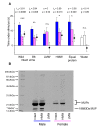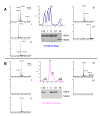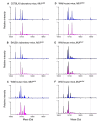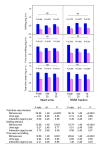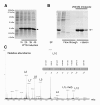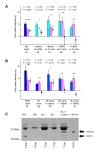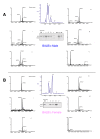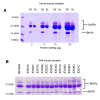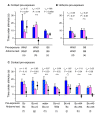Darcin: a male pheromone that stimulates female memory and sexual attraction to an individual male's odour - PubMed (original) (raw)
Darcin: a male pheromone that stimulates female memory and sexual attraction to an individual male's odour
Sarah A Roberts et al. BMC Biol. 2010.
Abstract
Background: Among invertebrates, specific pheromones elicit inherent (fixed) behavioural responses to coordinate social behaviours such as sexual recognition and attraction. By contrast, the much more complex social odours of mammals provide a broad range of information about the individual owner and stimulate individual-specific responses that are modulated by learning. How do mammals use such odours to coordinate important social interactions such as sexual attraction while allowing for individual-specific choice? We hypothesized that male mouse urine contains a specific pheromonal component that invokes inherent sexual attraction to the scent and which also stimulates female memory and conditions sexual attraction to the airborne odours of an individual scent owner associated with this pheromone.
Results: Using wild-stock house mice to ensure natural responses that generalize across individual genomes, we identify a single atypical male-specific major urinary protein (MUP) of mass 18893Da that invokes a female's inherent sexual attraction to male compared to female urinary scent. Attraction to this protein pheromone, which we named darcin, was as strong as the attraction to intact male urine. Importantly, contact with darcin also stimulated a strong learned attraction to the associated airborne urinary odour of an individual male, such that, subsequently, females were attracted to the airborne scent of that specific individual but not to that of other males.
Conclusions: This involatile protein is a mammalian male sex pheromone that stimulates a flexible response to individual-specific odours through associative learning and memory, allowing female sexual attraction to be inherent but selective towards particular males. This 'darcin effect' offers a new system to investigate the neural basis of individual-specific memories in the brain and give new insights into the regulation of behaviour in complex social mammals.See associated Commentary http://www.biomedcentral.com/1741-7007/8/71.
Figures
Figure 1
Female sexual attraction to male urine. (A) Total time spent under urine stimuli from males (blue bars) and from matched females (pink bars), together with the difference in time spent under male minus female stimulus (circles), plotted as means ± standard error of mean. Significant P values indicate greater attraction to the male stimulus (matched pair _t_-tests of log transformed data (t) or Wilcoxon matched pair tests (z) when transformed data did not approximate normality). Wild: urine from a random selection of wild males and females (n = 15); B6: normal intact B6 urine (n = 12); low molecular weight (LMW) urine fraction (< 3 kDa, n = 12): high molecular weight (HMW) urine fraction (≥ 3 kDa, n = 12); equal protein: male urine diluted to the same protein concentration as female urine (n = 12); water (open bars): two water stimuli (n = 10). The breakdown of time sniffing each stimulus and time under each stimulus not sniffing is shown in Figure S1. (B) Intact urine, HMW and LMW fractions from C57BL/6 (B6) male and female mice resolved by 15% one dimensional SDS-PAGE. Major urinary proteins (MUPs) were the only major protein bands observed, including a male-specific 18893Da MUP (darcin) which shows unusually high mobility for its size on reducing SDS-PAGE and appears as a band equivalent to 16 kDa [32].
Figure 2
Separation of urinary proteins in B6 mouse urine by anion exchange chromatography. Urinary proteins from (A) adult male and (B) adult female B6 mice were separated by strong anion-exchange chromatography, monitored by ultraviolet (UV) absorbance (central trace, blue or pink line). Four specific fractions corresponding to peak UV absorbance were collected from male urine, together with the corresponding fractions from female urine (I - IV). The protein masses in each of these four fractions, along with unfractionated MUPs, were analysed by electrospray ionisation mass spectrometry (outer traces), confirming that each mass corresponded to a known MUP mass in B6 mice [28]. Male fractions I and IV each contained a single male-specific MUP with a mass that was not detectable in matching female fractions. Resolution of each fraction on SDS-PAGE confirmed the absence of MUPs in female fractions I and IV, while male fraction IV contained the male-specific high mobility 18893Da MUP, darcin.
Figure 3
Female sexual attraction to urine fractions separated by anion exchange chromatography containing different major urinary proteins (MUPs). Total time spent under urine stimuli from B6 males (blue bars) and from matched females (pink bars), together with the difference in time spent under male minus female fraction (circles), plotted as means ± standard error of mean. Significant P values indicate greater attraction to the male stimulus (matched pair _t_-tests of log transformed data (t) or Wilcoxon matched pair tests (z) when log transformed data did not approximate normality); n.s. = no significant attraction to male. (A) Response to urine fractions containing different MUPs (separation shown in Figure 2). I: 18645Da MUP (in male fraction only); II: 18709Da MUP (both sexes); III: 18694Da and 18713Da MUPs (both sexes); IV: 18893Da MUP (darcin, male only). The protein concentration in each male and female fraction is given in Table 2. (B) Male fractions I and IV were subsequently tested against female fraction III. For each test n = 12 except fraction I which bordered on significance and sample size was increased to n = 17.
Figure 4
Variation in expression of the 18645Da major urinary protein (MUP) among laboratory and wild mice with different MUP genotypes. Electrospray ionisation mass spectra of urine samples with MUP Intensity expressed relative to the highest peak in each spectrum. Blue: male profiles; pink: female profiles; dashed lines highlight 18645Da and 18893Da. All laboratory mice examined to date exhibit strong male-biased expression of an 18645Da MUP (examples A and B). Some wild mouse MUP genotypes result in similar male-biased expression of an 18645Da MUP (C), some have no detectable expression of this mass (D and E) while some express the protein in both sexes (F). Note that the atypical 18893Da MUP (darcin) does not give a signal on electrospray ionisation mass spectrometry that reflects its abundance.
Figure 5
Female sexual attraction to intact urine or to the high molecular weight fraction of urine (≥ 3 kDa, HMW) according to stimulus age. Urine stimuli (10 μL) from male (blue bars) and female (pink bars) B6 mice were streaked onto 55 mm diameter glass microfibre filters cut in half and left to dry at room temperature for 5 min, 24 h or 7 days prior to testing. The effect of stimulus age and donor sex on response (log s + 1) to intact urine or to HMW was compared by repeated measures ANOVA with stimulus sex as a within-subjects factor and urine age as a between-subjects factor. P values on the graph show post-hoc t-tests which confirmed greater response to the male sample within each test. Log transformed data are plotted to illustrate the similarity of response between tests.
Figure 6
Expression and purification of recombinant darcin (r-darcin). E.coli BL21(λ)DE3 cells wer e transformed with a pET28b plasmid and at hourly intervals after induction cells were removed and lysed in water. The equivalent of 0.1 A600 of lysate was loaded into each lane of a 15%(w/v) polyacrylamide gel (panel A). The cell lysate was passed through a 1.2 mm filter and applied directly to a NiNTA metal affinity column column equilibrated with 50 mM sodium phosphate, 10 mM imidazole, 0.3 M NaCl pH8.0. The column was washed in the same buffer containing 20 mM imidazole and bound r-darcin was eluted by increasing the imidazole concentration to 250 mM (panel B). The purified r-darcin was subjected to in gel digestion with endopeptidase LysC and the peptides were analysed by MALDI-ToF mass spectrometry. All LysC peptides of mass greater than 800Da were readily detected in the MALDI-ToF spectrum, confirming the expression of the correct protein (panel C).
Figure 7
Female sexual attraction to male urine is elicited by darcin. Total time spent under test male stimulus (blue bars: male urine; cyan bars: recombinant major urinary protein (MUP) alone; hatched bars: male urine plus recombinant MUP) and matched control stimulus (pink bars: BALB/c female urine; open bar: buffer), together with the difference in time spent under test minus control (circles), plotted as means ± standard error of mean. Significant P values indicate greater attraction to the test male stimulus [matched pair t-tests of log transformed data (t)]. Control tests using intact urine from C57BL/6 strain [B6, A(a)] or a random selection of n = 14 wild males [Wild, B(f)] confirmed greater attraction to male urine. No attraction was shown towards BALB/c male urine [Bc, B(g)] which contained an extremely low level of darcin. Recombinant darcin (r-darcin, 11 μg) stimulated significant attraction when presented alone [A(b,c)] and when added to male BALB/c urine [B(h)]. There was no attraction to other recombinant MUPs (r-18694Da; r-18645Da). SDS-PAGE of urine stimuli (C), equivalent to one-thirtieth of the amount used in behavioural tests. The different mobility of r-darcin relative to native darcin is a consequence of the C-terminal His-tag used for purification (see Additional File 1: Figure S4).
Figure 8
Separation of urinary proteins in BALB/c mouse urine by anion exchange chromatography. Urinary proteins from (A) adult male and (B) adult female BALB/c mice were separated by strong anion-exchange chromatography, monitored by ultraviolet (UV) absorbance (central trace, blue line). Five specific fractions corresponding to peak UV absorbance were collected from male urine, together with the corresponding fractions from female urine (I - V). The protein masses in each of these five fractions, along with the starting material (SM), were analysed by electrospray ionisation mass spectrometry (outer traces). Male fractions I and V contained male specific major urinary proteins (MUPs) that were not detectable in the female fractions. Resolution of each fraction on SDS-PAGE confirmed that male fraction V contained a very low abundance of the male-specific high mobility 18893Da MUP, darcin, which was not detectable in the female fraction. See Figure 1 for explanation of the molecular weight labelling on SDS-PAGE.
Figure 9
Expression of darcin in C57BL/6, BALB/c and wild male mice. Panel A: Urine from male adult mice of C57BL/6 (B6) or BALB/c (Bc) strains was resolved on SDS-PAGE at different loadings, from normal (2 μg of protein) to heavily overloaded (20 μg of protein) lanes. The high mobility band corresponding to darcin was evident at all loadings in C57BL/6 mice, but was barely evident at 10 μg and 20 μg loadings from BALB/c mice. Densitometric analysis of this gel indicated that darcin constituted approximately 15% of the total major urinary protein (MUP) in C57BL/6 mice, but less than 0.5% of total MUP in BALB/c mice. Panel B: Protein (5 μg) from a number of adult, male, wild-derived mice was analysed by SDS-PAGE. The darcin band, confirmed by mass spectrometry to be darcin, was evident in every animal, at levels similar to that seen in C57BL/6 mice. We do not have an explanation for the doublet in animal ID5343, but it is possible that this mouse is heterozygous for two darcin genes - the upper band has tryptic peptides that match to the darcin sequence [32].
Figure 10
Contact with darcin in male urine stimulates learning and subsequent attraction to airborne urinary odours specific to that individual male. Females were pre-exposed to full contact with urine test stimuli (A, C) or to airborne odours only (B) before being tested with airborne odours from a male versus female urine stimulus that could not be contacted during the test. Displayed is the total time spent under airborne urine stimuli from males (blue bars: urine; hatched bars: urine plus recombinant major urinary protein MUP) and females (pink bars), together with the difference in time spent under male minus female stimulus (circles), plotted as means ± standard error of mean. Significant P values indicate greater attraction to the male airborne stimulus (matched pair _t_-tests on log transformed data (t), or Wilcoxon matched pair tests (z) when transformed data did not approximate normality). Male urine stimuli: Wild1, Wild2 = random selection of wild-derived males; B6 = C57BL/6 inbred strain; Bc = BALB/c inbred strain; Bc + rd = r-darcin added to male BALB/c urine (11 μg in 10 μL urine); Bc + r94 = recombinant 18694Da MUP added to BALB/c urine (11 μg in 10 μL urine); Bc + r45 = recombinant 18645Da MUP added to male BALB/c urine (11 μg in 10 μL urine). A standard BALB/c female stimulus was used in all tests.
Comment in
- On the scent of sexual attraction.
Brennan PA. Brennan PA. BMC Biol. 2010 Jun 3;8:71. doi: 10.1186/1741-7007-8-71. BMC Biol. 2010. PMID: 20504292 Free PMC article.
Similar articles
- Individual odour signatures that mice learn are shaped by involatile major urinary proteins (MUPs).
Roberts SA, Prescott MC, Davidson AJ, McLean L, Beynon RJ, Hurst JL. Roberts SA, et al. BMC Biol. 2018 Apr 27;16(1):48. doi: 10.1186/s12915-018-0512-9. BMC Biol. 2018. PMID: 29703213 Free PMC article. - The pheromone darcin drives a circuit for innate and reinforced behaviours.
Demir E, Li K, Bobrowski-Khoury N, Sanders JI, Beynon RJ, Hurst JL, Kepecs A, Axel R. Demir E, et al. Nature. 2020 Feb;578(7793):137-141. doi: 10.1038/s41586-020-1967-8. Epub 2020 Jan 29. Nature. 2020. PMID: 31996852 - Female recognition and assessment of males through scent.
Hurst JL. Hurst JL. Behav Brain Res. 2009 Jun 25;200(2):295-303. doi: 10.1016/j.bbr.2008.12.020. Epub 2008 Dec 25. Behav Brain Res. 2009. PMID: 19146884 Review. - Lymphocytic Choriomeningitis Virus Alters the Expression of Male Mouse Scent Proteins.
Oldstone MBA, Ware BC, Davidson A, Prescott MC, Beynon RJ, Hurst JL. Oldstone MBA, et al. Viruses. 2021 Jun 21;13(6):1180. doi: 10.3390/v13061180. Viruses. 2021. PMID: 34205512 Free PMC article. - From sexual attraction to maternal aggression: when pheromones change their behavioural significance.
Martín-Sánchez A, McLean L, Beynon RJ, Hurst JL, Ayala G, Lanuza E, Martínez-Garcia F. Martín-Sánchez A, et al. Horm Behav. 2015 Feb;68:65-76. doi: 10.1016/j.yhbeh.2014.08.007. Epub 2014 Aug 23. Horm Behav. 2015. PMID: 25161057 Review.
Cited by
- Synchronous evolution of an odor biosynthesis pathway and behavioral response.
Li Q, Korzan WJ, Ferrero DM, Chang RB, Roy DS, Buchi M, Lemon JK, Kaur AW, Stowers L, Fendt M, Liberles SD. Li Q, et al. Curr Biol. 2013 Jan 7;23(1):11-20. doi: 10.1016/j.cub.2012.10.047. Epub 2012 Nov 21. Curr Biol. 2013. PMID: 23177478 Free PMC article. - Identification and Application of Gene Expression Signatures Associated with Lifespan Extension.
Tyshkovskiy A, Bozaykut P, Borodinova AA, Gerashchenko MV, Ables GP, Garratt M, Khaitovich P, Clish CB, Miller RA, Gladyshev VN. Tyshkovskiy A, et al. Cell Metab. 2019 Sep 3;30(3):573-593.e8. doi: 10.1016/j.cmet.2019.06.018. Epub 2019 Jul 25. Cell Metab. 2019. PMID: 31353263 Free PMC article. - Identification and Field Testing of Volatile Components in the Sex Attractant Pheromone Blend of Female House Mice.
Varner E, Gries R, Takács S, Fan S, Gries G. Varner E, et al. J Chem Ecol. 2019 Jan;45(1):18-27. doi: 10.1007/s10886-018-1032-3. Epub 2018 Nov 9. J Chem Ecol. 2019. PMID: 30411204 - Amygdaloid projections to the ventral striatum in mice: direct and indirect chemosensory inputs to the brain reward system.
Novejarque A, Gutiérrez-Castellanos N, Lanuza E, Martínez-García F. Novejarque A, et al. Front Neuroanat. 2011 Aug 22;5:54. doi: 10.3389/fnana.2011.00054. eCollection 2011. Front Neuroanat. 2011. PMID: 22007159 Free PMC article. - Commentary: Spatial Olfactory Learning Contributes to Place Field Formation in the Hippocampus.
Lebedev MA, Ossadtchi A. Lebedev MA, et al. Front Syst Neurosci. 2018 Apr 10;12:8. doi: 10.3389/fnsys.2018.00008. eCollection 2018. Front Syst Neurosci. 2018. PMID: 29692712 Free PMC article. No abstract available.
References
- Karlson P, Luscher M. Pheromones': a new term for a class of biologically active substances. Nature. 1959;183:55–56. - PubMed
- Wyatt TD. Fifty years of pheromones. Nature. 2009;457:262–263. - PubMed
- Witzgall P, Kirsch P, Cork A. Sex pheromones and their impact on pest management. J Chem Ecol. pp. 80–100. - PubMed
- Beauchamp GK, Doty RL, Moulton DG, Mugford RA. In: Mammalian Olfaction, Reproductive Processes, and Behavior. Doty RL, editor. New York: Academic Press; 1976. The pheromone concept in mammals: a critique; pp. 143–160.
- Doty RL. The great pheromone myth: mammalian pheromones, audiomones, visuomones and snarks. Baltimore: John Hopkins University Press; 2010.
Publication types
MeSH terms
Substances
LinkOut - more resources
Full Text Sources
Other Literature Sources
Medical
Molecular Biology Databases
